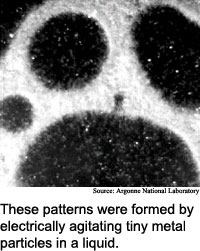
Juiced liquid jolts metal into
shapes
One strategy for constructing microscopic
devices is finding ways to make materials assemble themselves.
Researchers from Argonne National Laboratory and the Russian Academy
of Sciences have found a way to use electricity to drive metal microparticles
into patterns.
The self-assembly process could be used to construct micromachines
and materials, including materials useful in space.
The researchers immersed 120-micron bronze spheres in a mix of toluene
and ethanol, which does not conduct electricity well, and trapped them between
glass plates coated with conducting material. A micron is one-thousandth
of a millimeter. The researchers used an electric field to shake the tiny
spheres into shapes: the field caused spheres in contact with the lower
plate to be repelled back and forth between the plates.
The process caused the particles to form patterns like rings and
honeycombs. The shape depends on how the flow of the poorly-conducting liquid
affects the charged spheres.
The method could be used to make nanoscale structures in three to
four years, and it could be used to form materials that improve heat transfer
in space applications in 10 years, according to the researchers. The work
appeared in the March 21, 2003 issue of Physical Review Letters.
Nanocomputer skips clock
DNA motor keeps cranking
Software sorts tunes
Silver bits channel nano light
News briefs:
Tiny drug capsules shine
Degree of difference sorts data
Casting yields non-carbon nanotubes
Material makes backwards lens
Juiced liquid jolts metal into shapes
Nanotube web could mimic brain

Research Watch blog
View from the High Ground Q&A
How It Works
RSS Feeds:
News
Ad links:
Buy an ad link
Ad links: Clear History
Buy an ad link
|
TRN
Newswire and Headline Feeds for Web sites
|
© Copyright Technology Research News, LLC 2000-2010. All rights reserved.